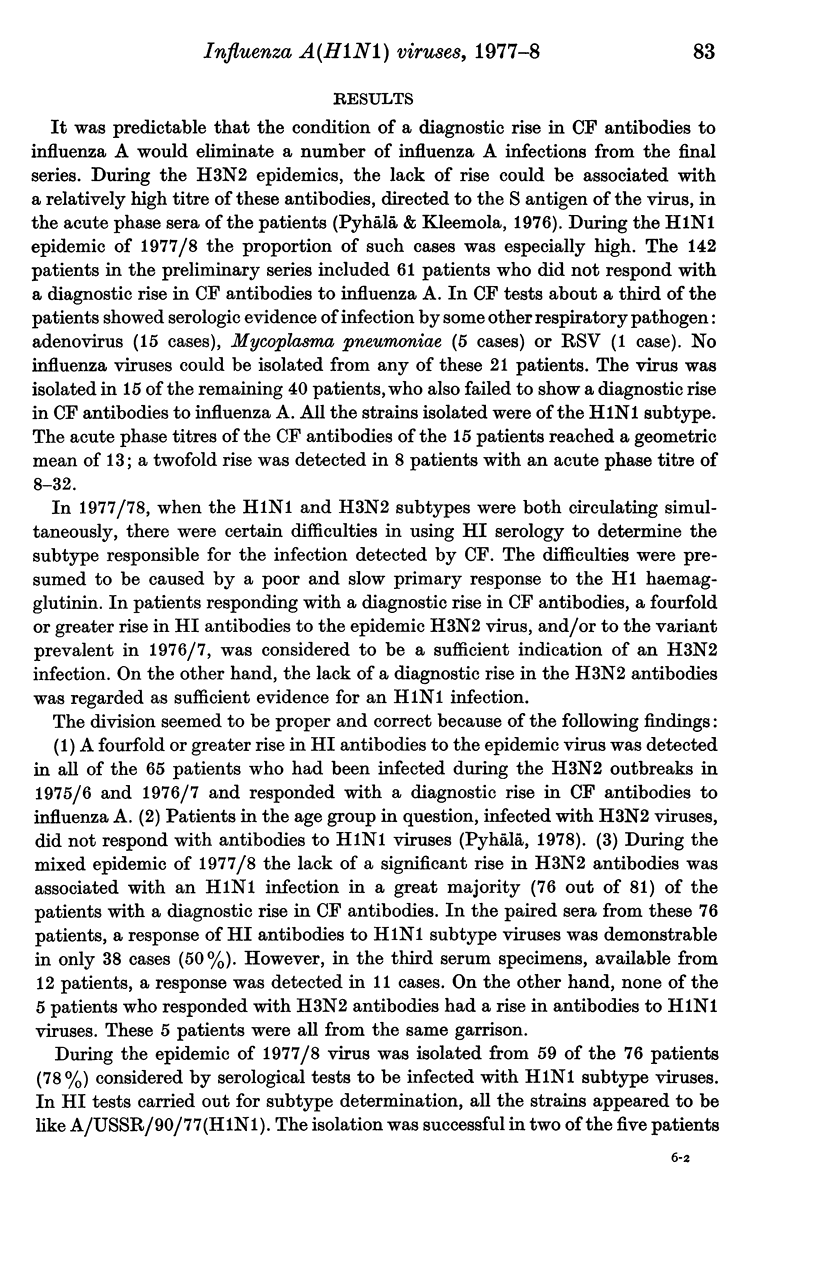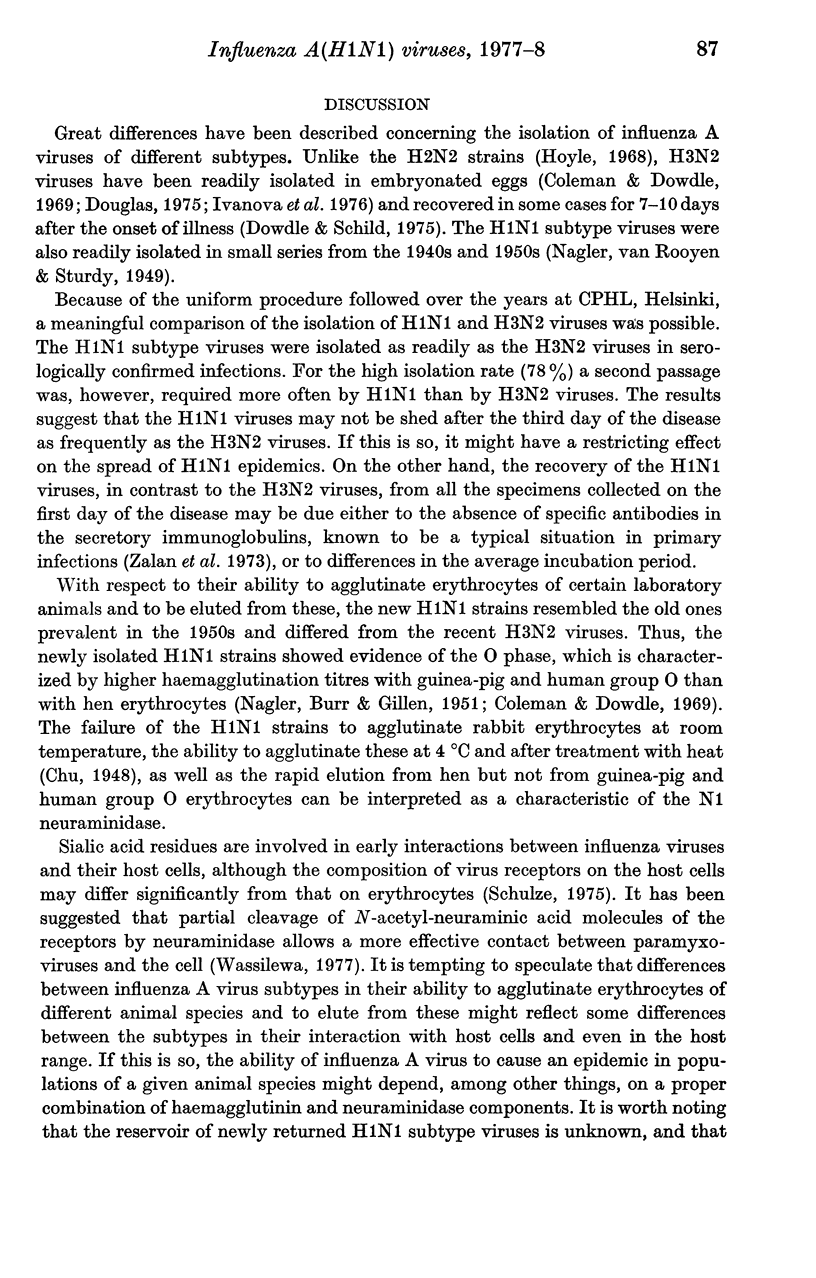Abstract
During the H1N1 outbreak of 1977/8, the virus was isolated in embryonated eggs from 59 out of 76 patients (78%) with the serologically confirmed infection. A similar isolation frequency has been achieved during a period of six H3N2 outbreaks since 1972/3. The H1N1 strains were isolated less frequently from late specimens (collected 4--6 days from the onset of illness) and more often only in the second passage compared with the H3N2 viruses. The new H1N1 strains resembled those prevalent in the 1950s with respect to their ability to agglutinate erythrocytes of certain laboratory animals and to be eluted from these, and thus differed from the H3N2 viruses.
Full text
PDF







Selected References
These references are in PubMed. This may not be the complete list of references from this article.
- CASEY H. L. STANDARDIZED DIAGNOSTIC COMPLEMENT FIXATION METHOD AND ADAPTATION TO MICRO TEST. I. LABORATORY BRANCH COMPLEMENT FIXATION METHOD BY LABORATORY BRANCH TASK FORCE. II. ADAPTATION OF LBCF METHOD TO MICRO TECHNIQUE. Public Health Monogr. 1965;74:1–34. [PubMed] [Google Scholar]
- Coleman M. T., Dowdle W. R. Properties of the Hong Kong influenza virus. I. General characteristics of the Hong Kong virus. Bull World Health Organ. 1969;41(3):415–418. [PMC free article] [PubMed] [Google Scholar]
- Ivanova N. A., Taros L. Y., Grinbaum E. B., Rumel N. B., Kamforin L. E., Luzyanina T. Y. Results of virological and serological studies of three influenza A Hong-Kong epidemics in Leningrad. J Hyg Epidemiol Microbiol Immunol. 1976;20(2):186–194. [PubMed] [Google Scholar]
- Ivanova N. A., Taros L. Y., Grinbaum E. B., Rumel N. B., Kamforin L. E., Luzyanina T. Y. Results of virological and serological studies of three influenza A Hong-Kong epidemics in Leningrad. J Hyg Epidemiol Microbiol Immunol. 1976;21(2):186–194. [PubMed] [Google Scholar]
- NAGLER F. P., BURR M. M., GILLEN A. L. The influenza virus epidemic in Canada during January-February, 1951. Can J Public Health. 1951 Sep;42(9):367–374. [PubMed] [Google Scholar]
- NAGLER F. P., VAN ROOYEN C. E., STURDY J. H. An influenza virus epidemic at Victoria Island, N.W.T., Canada. Can J Public Health. 1949 Nov;40(11):457–465. [PubMed] [Google Scholar]
- Pyhälä R., Aho K., Kantanen M. L., Koistinen J. Virus antibody levels in IgA deficiency. Scand J Immunol. 1976;5(10):1093–1096. doi: 10.1111/j.1365-3083.1976.tb00248.x. [DOI] [PubMed] [Google Scholar]
- Pyhälä R., Aho K. Serum HI antibody and protection against influenza: a follow-up survey at community level of three epidemics caused by different H3N2-variants. Int J Epidemiol. 1975 Jun;4(2):127–129. doi: 10.1093/ije/4.2.127. [DOI] [PubMed] [Google Scholar]
- Wassilewa L. Cell receptors for paramyxoviruses. Arch Virol. 1977;54(4):299–305. doi: 10.1007/BF01314775. [DOI] [PubMed] [Google Scholar]
- Zalan E., Pukitis D., Rhodes A. J., Labzoffsky N. A. Interference of influenza-specific IgA antibodies present in throat washings with isolation of the virus. Arch Gesamte Virusforsch. 1973;42(3):307–310. doi: 10.1007/BF01265658. [DOI] [PubMed] [Google Scholar]


